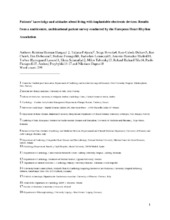Patients' knowledge and attitudes regarding living with implantable electronic devices: Results of a multicentre, multinational patient survey conducted by the European Heart Rhythm Association
Haugaa, Kristina; Potpara, Tatjana S.; Boveda, Serge; Deharo, Jean-Claude; Chen, Jian; Dobreanu, Dan; Fumagalli, Stefano; Lenarczyk, Radoslaw; Hernandez Madrid, Antonio; Larsen, Torben Bjerregaard; Sciarrafia, Elena; Taborsky, Milos; Tilz, Roland Richard; Pieragnoli, Paolo; Przybylski, Andrzej; Dagres, Nikolaos
Peer reviewed, Journal article
Accepted version
Permanent lenke
https://hdl.handle.net/1956/20290Utgivelsesdato
2018-02Metadata
Vis full innførselSamlinger
Originalversjon
https://doi.org/10.1093/europace/eux365Sammendrag
The purpose of this patient survey was to analyse the knowledge, experiences, and attitudes regarding cardiac implantable electronic devices (CIED) in patients with pacemakers, implantable cardioverter-defibrillators (ICDs), or cardiac resynchronization devices. Of the 1644 patients with CIEDs from seven European countries, 88% were over 50 years of age. Most patients (90%) knew what device they were implanted with and felt sufficiently informed about the indications for therapy. As many as 42% of patients needed additional information on the battery replacement and limitations in physical activity. The self-reported incidence of complications was 9%, and among these, a quarter of the respondents felt insufficiently informed about the possibility of complications and their management. The majority of patients (83%) were followed by face-to-face visits, which was the most commonly preferred follow-up strategy by the patients. Nearly 75% of the patients reported improved quality of life after device implantation, but about 40% had worries about their device. Less than 20% had discussed with their physician or thought about device handling in the end-of-life circumstances or end-stage disease. Notably, almost 20% of the ICD patients did not wish to answer the question regarding what they wanted to be done with their ICD in case of end-stage disease, indicating the challenges in approaching these issues.
